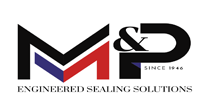What is Waterjet Cutting?
Waterjet cutting (also known as hydrocutting) is a manufacturing process that operates under computer numerical control (CNC) to apply a high velocity and pressure stream of water that slices through a variety of soft and hard materials. Metal, stone, plastics, composites, glass ceramics, and rubber – there are virtually no limits to what waterjet machines can cut. Although the basic technology behind waterjet cutting has been used for many decades, it is only now becoming one of the fastest growing major machine tool processes in the world. M&P Sealing Inc is proud to offer this cutting edge manufacturing process to our customers.
By offering precision waterjet cutting services, M&P Sealing is able to cut materials into any shape up to 3-1/4″ thick with excellent edge quality and no heat-affected zone (HAZ). Minimizing the effects of heat allows materials, such as metals, to be cut without compromising their intrinsic properties. The accurate, clean edges M&P Sealing is able to produce allow for tight nesting and reduced scrap, which results in greater material utilization – a savings M&P Sealing is happy to pass on to every customer.
Types of CNC Waterjet Cutting Services
There are two types of waterjet cutting – pure waterjet and abrasive waterjet. M&P Sealing is able to operate both, even in the same job. Transforming one cutter to the other is done in minutes. While pure waterjet cutting is used to cut soft materials, such as cork, closed cell sponge, and solid rubber; abrasive waterjet cutting is used to cut hard materials, such as metals, stone, composites, and ceramics. In pure waterjet cutting, a supersonic stream of water works to erode the material, but in abrasive waterjet cutting, that stream of water is used to accelerate abrasive particles and it is those particles that work to erode the material.
Pure waterjet cutting results in extremely detailed geometry of soft, light weight, and flexible materials; whereas abrasive waterjet can produce the same level of detail on materials with a hardness up to and slightly beyond aluminum oxide ceramic (often called alumina, AD 99.9). When compared with plasma, laser, and EDM, precision hydrocutting has distinct advantages.
| Waterjet | Plasma | Laser | EDM | |
|---|---|---|---|---|
| Process | Erosion process: high speed liquid sandpaper | Burning/Melting process using high temperature ionized gas arc | Melting process using concentrated laser light beam | Erosion process using electrical discharge |
| Materials | Any material | Primarily steel, stainless steel and aluminum | Primarily steel, stainless steel and aluminum
Can also cut a variety of other materials |
Conductive materials only |
| Thickness | Up to 24 inches, virtually any material
Z constraint is only limited to thickness |
Up to 2-3 inches, depending on material | Generally 1 inch or less, depending on materials | Generally 12 inches or less |
| Part Accuracy | Up to .001” | Up to .010” | Up to .001” | Up to .0001” |
| Machine Setup | Same setup for all materials | Different setup for different jobs | Different gases and parameters for different jobs | Different wire types for different jobs |
Contact M&P Sealing Inc. by phone at 1-800-351-0026 or by email at sales@mp-sealing.com to learn more about waterjet machining.
